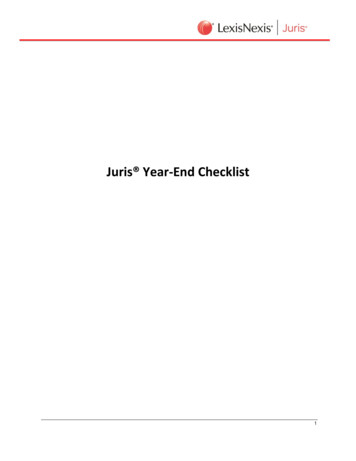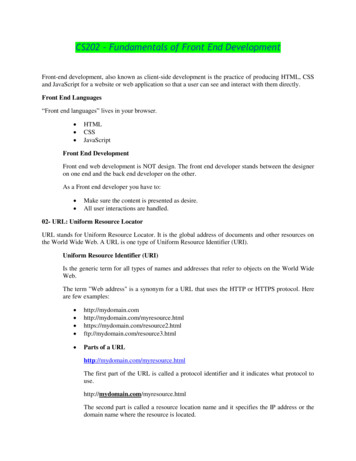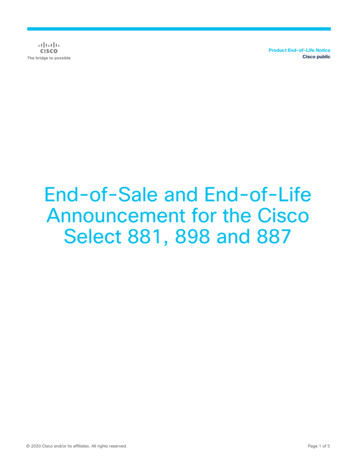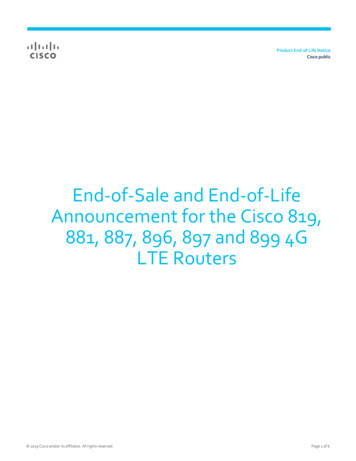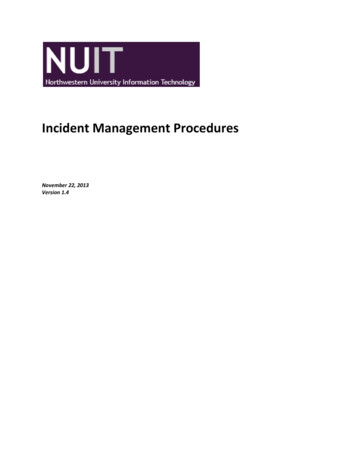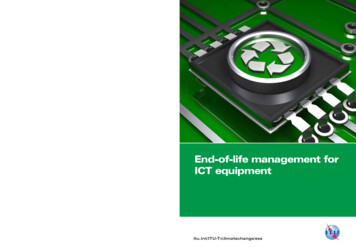
Transcription
"/0%1,-*(23*4%1*/%15-.* %(*#-7(/"1A6()B"1,)/5-C%(,%1 '&D%1-!"#" %&&'() * %(,--End-of-life management forICT equipment!"#" %&&'() * %(,-."/0%1,-*(2-------!"#"&* ,-3*4%1*/%15!"#" %&&'() * %(,-."/0%1,-*(2-------!"#"&* ,-3*4%1*/%15-6.789:;7! - 9 37-;!6 7- 76.789:;7! - 9 37-;!6 7- 7 9.?8@-.* %(*#-7(/"1A6()B"1,)/5-C%(,%1 '&.* %(*#-7(/"1A6()B"1,)/5-C%(,%1 '&D%1-!"#" %&&'() * %(,-D%1-!"#" %&&'() * %(,-- 9.?8@-September 2012About ITU-T and Climate Change: itu.int/ITU-T/climatechange/E-mail: greenstandard@itu.intPrinted in SwitzerlandGeneva, 2012Photo credits: Shutterstock itu.int/ITU-T/climatechange/ess
AcknowledgementsThis document is part of the ITU Toolkit on Environmental Sustainability for the ICT sector which was editedby Jyoti Banerjee (Fronesys) and Cristina Bueti (ITU).This document was researched and written by Laura Reyes (Datec), Shannon West (Verizon), FedericoMagalini and Ruediger Khuer (UNU/StEP Initiative), Tatiana Terekhova (UNEP/Secretariat of the BaselConvention), Gilles Dretsch (France Telecom/Orange) and Cristina Bueti (ITU).The authors would like to thank Elisabeth Dechenaux, Didier Marquet, Ahmed Zeddam (FranceTelecom/Orange), Gilbert Buty and Thomas Okrasinski (Alcatel Lucent) who gave up their time to review thedocument and to ensure coordination with ITU-T Study Group 5.Special thanks are due to the contributory organizations of the Toolkit on Environmental Sustainability forthe ICT Sector for their helpful review of a prior draft.Additional information including the full list of contributory organizations can be found at:www.itu.int/ITUT/climatechange/ess/index.htmlIf you would like to provide any additional information, please contact Cristina Bueti at tsbsg5@itu.int.Legal NoticeThis publication may be updated from time to time.Third-party sources are quoted as appropriate. The International Telecommunication Union (ITU) and thecontributory organizations are not responsible for the content of external sources including externalwebsites referenced in this publication.DisclaimerThe views expressed in this publication are those of the authors and do not necessarily reflect the views ofthe International Telecommunication Union (ITU), its membership or contributory organizations. Mention ofand references to specific countries, companies, products, initiatives or guidelines do not in any way implythat they are endorsed or recommended by ITU, the authors, or any other organization that the authors areaffiliated with, in preference to others of a similar nature that are not mentioned.Requests to reproduce extracts of this publication may be submitted to: jur@itu.int ITU 2012All rights reserved. No part of this publication may be reproduced, by any means whatsoever, without theprior written permission of ITU.
End-of-life managementof ICT equipment
Table of contentsPageEnd-of-life management of ICT equipment . 1Executive summary . 1The Toolkit . 21Introduction . 31.1 Target audience .31.2 Objectives .32End-of-life management . 42.1 Definition of end-of-life for ICT equipment .42.1.1 Definition of environmentally sound management of e-waste.52.2 General description of the end-of-life management chain for ICT equipment .62.2.1 Transboundary movements of hazardous wastes and other wastes .72.3 End-of-life Management: Organisation-wise Steps . 102.3.1 From an Internal Perspective . 102.3.2 From High-Technology Business Districts. 112.3.3. From a Donations receptor perspective. 112.4 End-of-life management: stages and waste hierarchy . 112.4.1 General legal framework . 122.4.2 Asset management . 122.4.3 Secure information management . 132.4.4 Reverse logistics . 142.4.5 Dismantling and segregation . 152.4.6 Refurbishment . 162.4.7 Reuse . 182.4.8 Recycling and recovery . 192.4 A guide to best practice . 243General material recovery and recycling facility guidelines . 293.1 Environmental management system, licences and permits . 303.2 Monitoring and record keeping . 303.3 Emergency planning . 313.4 Occupational health and safety: best practices to ensure workers’ safety . 313.5 Personal protective equipment . 313.6 Employee training . 323.7 Financial guarantees . 324Clean supply chain and conflict minerals . 35End-of-life management of ICT equipmentiii
5Socio-economic issues . 396Offsetting opportunities and mitigation . 426.1 Corporate social responsibility (CSR) . 426.2 CO2 management . 427Case studies . 448Checklists . 468.1 An internal prospective . 468.2 The perspective of high-technology business districts . 488.3 The perspective of a donation receptor . 489Conclusions . 499.1 Suggestions to ITU-T SG 5 . 491. ICT product design issues . 492. Technical guidance applicable to refurbishment and repair facilities as well as marketing ofused ICT equipment . 493. Environmental and socio-economic aspects . 494. Principles for donors of ICT equipment . 505. Development of national ICT policies . 506. Map guidance document on ICT applicable standards and legislation . 507. Development of a global CO2 – equivalent market . 508. Recovery of rare metals and green ICT supply chain . 5010 Glossary . 5111 Bibliography . 5312 Annexes. 54Annex I . 54Annex II Disposal operations (Annex IV of the Basel Convention) . 56A. Operations which do not lead to the possibility of resource recovery, recycling, reclamation,direct reuse or alternative uses. 56B. Operations which may lead to resource recovery, recycling reclamation, direct reuse oralternative uses . 57Annex III General references to the legislation, international standards and guidance documents . 58ivEnd-of-life management of ICT equipment
End-of-life management of ICT equipmentExecutive summaryThe growing volumes of end-of-life (EOL)and near end-of-life ICT equipment around the globe is becoming amatter of concern, particularly as ICT equipment is characterized by high demand and a relatively shortlife-span. The failure to close the loop on e-waste leads not only to significant adverse environmentalimpacts, but also to the systematic depletion of the resource base of secondary equipment.This document provides a definition of EOL management of ICT equipment, an outline of the various EOLstages (and accompanying legislation that applies to the stages), and a checklist that assists an organizationin creating a framework for environmentally-sound management of EOL ICT equipment.When equipment no longer satisfies the initial user’s needs, we should not assume that it is in pooroperational condition or has become obsolete. Instead, it may be possible to extend its life through use forthe same purposes by other users. Or, it can be reused (in part or whole) for other purposes. Or, thematerials contained within it can be recovered and recycled.Decisions relating to whether the life of a piece of equipment can be extended starts with its owner, butextends to a large group of stakeholders who deal with the manufacture, transport, reuse, refurbishment,recycling, and disposal of ICT equipment.Once it is decided that a piece of equipment is waste, it helps to apply a “waste hierarchy” to minimize thegeneration of waste. This requires using alternatives such as waste prevention, reduction, reuse, recyclingand recovery of equipment before considering the possibility of disposal. Alongside these issues are relatedmanagement issues, such as valuing the EOL assets and dealing with the security of the data that might bestored on those assets. A check-list is provided as a guide so that each of the EOL stages are dealt with, andnot overlooked.The document provides guidance for the recovery and recycling of materials contained in ICT equipment,and also discusses issues surrounding the use of conflict minerals in the context of clean supply chains.Ultimately, for many organizations, their actions on EOL and e-waste are often tied to the choices they makeregarding corporate social responsibility. In effect, smart management of their EOL assets can help themfulfil their duty to society. But, such actions should also lead to competitive business opportunities.End-of-life management of ICT equipment1
The toolkitThis document on End- of-life management of ICT equipment is part of a set of documents that togetherform the Toolkit on environmental sustainability for the ICT sector. The toolkit is the result of an ITU-Tinitiative, carried out together with over fifty partners, which provides detailed support on how ICTcompanies can build sustainability into the operations and management of their organizations. Thedocuments in the toolkit cover the following: Introduction to the toolkit Sustainable ICT in corporate organizations, focusing on the main sustainability issues that companiesface in using ICT products and services in their own organizations across four main ICT areas: datacenters, desktop infrastructure, broadcasting services and telecommunications networks. Sustainable products, where the aim is to build sustainable products through the use ofenvironmentally-conscious design principles and practices, covering development and manufacture,through to end-of-life treatment. Sustainable buildings, which focuses on the application of sustainability management to buildingsthrough the stages of construction, lifetime use and de-commissioning, as ICT companies build andoperate facilities that can demand large amounts of energy and material use in all phases of the lifecycle. End-of-life management, covering the various EOL stages (and their accompanying legislation) andprovides support in creating a framework for environmentally-sound management of EOL ICTequipment. General specifications and key performance indicators, with a focus on the matching environmentalKPIs to an organization’s specific business strategy targets, and the construction of standardizedprocesses to make sure the KPI data is as useful as possible to management. Assessment framework for environmental impacts, explores how the various standards and guidelinescan be mapped so that an organization can create a sustainability framework that is relevant to theirown business objectives and desired sustainability performance.Each document features a discussion of the topic, including standards, guidelines and methodologies thatare available, and a check list that assists the sustainability practitioner make sure they are not missing outanything important.2End-of-life management of ICT equipment
1IntroductionNowadays ICT equipment is characterized by high demand and relatively short life-span. The growingvolumes of end-of-life and near-end-of-life ICT equipment around the globe is becoming a matter ofconcern. That is why it is important to specifically consider the end-of-life (EOL) management of ICTequipment, in particular, its aspects dealing with the sustainable use and disposal methods. End-of-lifeelectronic and electrical equipment or e-waste is often viewed from a negative angle as simply anotherwaste problem causing environmental and health adverse impacts, if not dealt with appropriately. However,the enormous impact of ICT equipment on resources is widely overlooked.The failure to close the loop on e-waste leads not only to significant adverse environmental impacts, butalso to the systematic depletion of the resource base of secondary equipment. Even thoughtelecommunications is an industry of considerable energy consumption, it can also be a potential source ofenvironmental benefits. Thus, it is critical to identify the key factors of success for the minimization andcontrol of negative environmental impacts. This includes impacts generated by potentially inadequatesolutions that could also represent contradictions to today’s governmental environmental targets andstandards, as well as to global trends and efforts specific to the ICT industry.This document on End-of-life management is part of the ITU-T’s Toolkit on environmental sustainability forthe ICT sector.1.1Target audienceThe target audience of this document are public and private organizations that manufacture, possess,commercialize, or use ICT equipment as part of their final product, offer services or as part of theirfunctional infrastructure to transmit, support or deliver those services, products and supply chain.The document provides a definition of the end-of-life management of ICT equipment and e-waste, followedby a description of EOL stages for ICT equipment and the applicable legislation. This ensures properprocedures and apportions responsibility to the stakeholders involved in the EOL through the provision of achecklist with specific questions and pointers for an environmentally sound management of EOL ICTequipment.This document lists basic and minimum requirements for the EOL management that the actors engaged inthis field should comply with, thus offering an important tool for decision-making for the EOL stage of themanagement of ICT equipment. It also introduces the reader to today’s global efforts on the developmentof a clean supply chain and conflict minerals for ICT equipment as well as a brief description of the socioeconomic issues.Finally, this document describes the existing off-setting opportunities, possibilities for the development offuture markets and several success stories on the reuse, refurbishing and recycling of ICT equipment.1.2ObjectivesFirst, this document aims to give directions on how to find an environmentally sustainable solution for EOLequipment by providing a checklist that allows full monitoring of the decisions made in relation to ICT EOLmanagement practices. For this purpose this document is designed to: describe the EOL management stages for ICT equipment and their hierarchy based on the principle ofwaste prevention (e.g. reuse, recycle, recovery, refurbishment, disposal) in order to protect humanhealth, the environment as well as to support sustainable development; identify key challenges, opportunities and limitations faced by an EOL management provider at thedifferent stages of ICT equipment management.End-of-life management of ICT equipment3
Secondly, this document aims to present different initiatives relevant to the EOL management which may beof interest to different companies, associations and other interested organizations (e.g. operators,manufacturers as well as end-users) and which may prove to be useful when looking for an EOLmanagement solution. Such a solution should not only support the economic growth but also take intoconsideration the extended responsibility of producers and generators in relation to their ICT equipment onthe local, national, regional and global scale.This document identifies social, economic and environmental aspects related to the EOL management of ICTequipment.Finally, this document intends to illustrate how the end-of-life management and its environmental aspectcan be integrated into the design process as part of the life-cycle approach within the framework which isdeveloped by the ITU-T Study Group 5 (SG 5).2End-of-life management2.1Definition of end-of-life for ICT equipmentEquipment reach its end-of-life once it becomes dysfunctional for the owner/user, becoming what someclassify as waste for the particular need the user has, according to Morselli et al., 2006. The BaselConvention1 on the Control of Transboundary Movements of Hazardous Wastes and their Disposal (the‘Basel Convention’) defines waste as substances or objects which are disposed of or are intended to bedisposed of or are required to be disposed of by the provisions of national law.However, when the equipment no longer satisfies the initial user’s need, this does not necessarily meanthat it is in poor operational condition or has become obsolete. On the contrary, this could be anopportunity for its life to be extended by either being used for the same purposes by other users whoseneeds can be satisfied with this equipment, or by reusing the equipment or its parts and components, inwhich case it is necessary to dismantle the equipment to recover its parts. It is also possible to extend theuse of the material contained within it through part, component or material recovery and recycling, betterknown as the end-of-life management of ICT equipment.Decisions related to extending the life of ICT equipment or choosing providers for ICT EOL practices belongto the owner or possessor who will decide to carry out this work on its own or commission a specializedcompany.Whether the decision is made to either extend the life of equipment or to proceed with recovery andrecycling, it must be done in compliance with environmentally sound management practices and techniques.In this regard, it is important to ensure that the service provider possesses high environmental performancecapabilities.Thus, it is important to employ the best available techniques and environmental practices for EOL of ICTequipment, which will determine the success of an environmentally responsible and sustainable outcome,without compromising economic goals. This also applies to the end-user equipment which needs to enterthe collection system for the environmentally sound management reuse, recycling and disposal.The end-of-life management of ICT equipment provides for different options offered to ICT users regardinghow to recover value, securely remove data and dispose their equipment in a responsible and sustainablemanner. However, end-of-life management should not be mistaken for end-of-use of ICT equipment which1See Annex II of this document.4End-of-life management of ICT equipment
is no longer used as intended by the previous owner, but may be fully functional and used appropriately byothers.It is advisable to conduct a functionality test, as suggested in Annex I: Table 1: Example of functionality testsfor used computing equipment, as it can help to determine the best available options for either theextension or end-of-life treatment according to the state of the particular item.One should bear in mind that in certain cases the entire item may not be considered in good operationalconditions; however, its parts and components would, most of the time be in a good operational condition,which can be determined by running specific tests, usually in specialized facilities. To treat those parts andcomponents as waste and directly dispose of them may be detrimental to the environment and a potentialeconomic loss. There is an ongoing work as per Decision BC-10-3 of the Basel Convention to provide legalclarity of terms related to the implementation of the Basel Convention, including waste/non-waste, secondhand goods, used goods, reuse, direct reuse.Certain ICT products use complex technology and require more specialized testing methodologies that maybe not available for general use. Telecommunication base stations and commercial mass storage systemsare typically recovered directly by the manufacturer or through their trusted specialist decommissioningcompanies from around the world.Transboundary movements of functional used ICT equipment destined for reuse (and not for operationslisted under section B of Annex IV of the Basel Convention) are usually not subject to the control proceduresof the Basel Convention (see 2.1 for more information). Under the Basel Convention certain Parties considerICT equipment destined for repair, refurbishment or downgraded to waste, while others do not. If one ofthe countries concerned considers this equipment to be waste, the procedures on transboundarymovements of e-waste should be followed.Currently, technical guidelines on transboundary movements of e-waste are being developed by the BaselConvention Secretariat which, when adopted by the Conference of the Parties to the Basel Convention, willprovide clear guidance on procedures for transboundary movements of used e-equipment and e-waste fordifferent purposes.Some argue that adding procedures, whether voluntary or mandatory, that aim to prevent illegal traffic ofe-waste would add cost, time and resources needed for good management and performance. However,clear and predictable rules would reduce the risks associated with uncertainty for companies whichtransport in good faith used goods intended for resource recovery, recycling, disposal, etc., and woulddiscourage producers or other players who look for “easier” solutions.2.1.1Definition of environmentally sound management of e-wasteThere are a number of definitions of e-waste used by various institutions and organizations; however, forthe purpose of this document, the definition of e-waste would be the one suggested by Morselli, et al. intheir 2009 publication “Waste Recovery, Strategies, Techniques and Applications in Europe” that reads asfollows:E-WASTE: “Any device that for functional reasons is dependent on electric currents or electro-magneticfields in order to work properly. It becomes e-waste when the holder discards, intends or requires todiscard”.Other definitions of e-waste include:“Waste electrical and electronic equipment’ or ‘WEEE’ means electrical or electronic equipment whichis waste within the meaning of Article 1(a) of Directive 75/442/EEC, including all components,End-of-life management of ICT equipment5
subassemblies and consumables which are part of the equipment at the time of discarding (EU WEEEDirective (EC/2002/96)).Electrical and electronic equipment that is no longer suitable for use or that the last owner hasdiscarded (Guidance Document on the Environmentally Sound Management of Used and End-of-LifeComputing Equipment, Partnership for Action on Computing Equipment (PACE)).”The question of whether the ICT equipment is to be considered functional or waste is of fundamentalimportance to all stakeholders dealing with the manufacturing, transport, reuse, refurbishment, recycling,disposal of ICT equipment as the control measures set up by the relevant legal regimes differ for functionalproduct or equipment and waste. In the case of ICT equipment, there are challenges to determinewhether/when the equipment should be considered waste. Therefore, the technical guidelines ontransboundary movements of e-waste, as referred to in subsection 1, aim to give guidance on how to clarifythis issue. One important aspect of the transformation of equipment into waste is the intent of its owner. Ifequipment is disposed of, intended to be or required to be disposed of using one of the operations listed inparts A or B of Annex IV of the Basel Convention2, this equipment will be defined as waste, and itstransboundary movements shall be subject to the Basel Convention3 control procedure. Companies in theICT sector may choose to engage a specialized asset management company to evaluate the equipment andto certify ICT equipment as waste, if necessary. For further clarification, one may contact the Basel NationalCompetent Authorities with questions regarding the classification of the equipment as waste (for thepurpose of transboundary movements) and any relevant national definitions of waste.In addition to the requirements of the Basel Convention, one must pay special attention to the applicablenational legal framework, in particular instances where the Basel Convention provisions (e.g. the definitionof “waste”) are further elaborated in the relevant rules and regulations, or where additional requirementsare established concerning procedures for transboundary movements (as permitted under paragraph 11 ofarticle 4 of the Convention). The following specific elements may be taken into account at the national level: The equipment or its components can be reused for the item’s original purpose; There is a market or demand for the equipment or its components and the equipment satisfies thetechnical requirements of the industry; The reuse of the equipment complies with the applicable requirements and does not lead toenvironmental or social risk; Contributes to climate change prevention by reducing and mitigating the effects of gas emissions; The market that demands the equipment or components for reuse or recycling has in place policiesand legislations t
Convention), Gilles Dretsch (France Telecom/Orange) and Cristina Bueti (ITU). The authors would like to thank Elisabeth Dechenaux, Didier Marquet, Ahmed Zeddam (France Telecom/Orange), Gilbert Buty and Thomas Okrasinski (Alcatel Lucent) who gave up their time to review the document and to ensure coordination with ITU-T Study Group 5.





